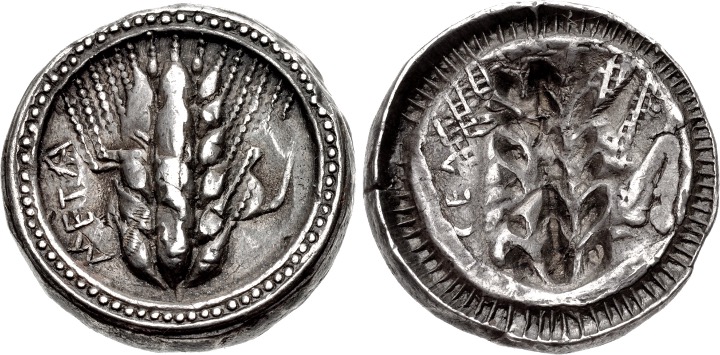1840 - Metapontum (nomos ear of barley/ear of barley) over Gela (horseman/man-faced bull) (Triton, I, Dec. 1997, 83)
From SILVER
540 BCE - 510 BCEMETA
Location/history
| Sale(s)Sale(s) ᵖ: | Triton XXII (08/01/2019), lot 25 ; Waddell inventory 50636 (2013) ; Triton 1 (02/12/1997), lot 83 ; Sangiorgi, (15/04/1907), lot 981. | |
| Private collection(s)Private collection(s) ᵖ: | Gasvoda Collection; A. D. Moretti collection; R. Jameson collection; C. Strozzi collection |
Overstriking coin
Description
| ObverseInscription or printing placed on the obverse.: | META (Greek) Ear of cereal. Decorated border. | ReverseInscription or printing placed on the reverse.: | Ear of grain. Border of rays (incuse). |
Mint and issuing power
| MintIdentifies the place of manufacture or issue of a numismatic object.: | Metapontum | Ancient regionAncient region. | Magna Graecia (Lucania) | Modern countryModern country: Italy | AuthorityIdentifies the issuing power. The authority can be "pretended" when the name or the portrait of X is on the coin but he/she was not the issuing power. It can also be "uncertain" when there is no mention of X on the coin but he/she was the issuing power according to the historical sources: |
Chronology
| FromIdentifies the initial date in a range assigned in a numismatic context. 540 BCE toIdentifies the final date in a range assigned in a numismatic context.. 510 BCE | Archaic until 480 BC |
Physical description
| MetalThe physical material (usually metal) from which an object is made.: Silver |
WeightWeight of the numismatic object (in grams). in grams: 8.168.16 g <br />8,160 mg <br /> | DenominationTerm indicating the value of a numismatic object. Examples: tetradrachm, chalkous, denarius.: stater / tridrachm / nomos | AxisDescribes the directional relationship between the obverse and reverse of a numismatic object.: 66 mm <br />0.6 cm <br /> |
| DiameterDescribes diameter of an object (in mm).: 20.520.5 mm <br />2.05 cm <br /> | StandardStandard.: Achaian | ||
References
| Coin referenceReference of the Coin: | Collection R. Jameson, n° 261 (https://gallica.bnf.fr/ark:/12148/btv1b532001970/f84.item), Noe 1927, Class XI, 255 (same dies, this coin referenced), Gorini, n° 28 | Coin series referenceReference to coin series study: | SNG ANS/Sylloge Nummorum Graecorum1SNG ANS/Sylloge Nummorum Graecorum, USA, The Collection of the American Numismatic Society (9 vols.), New York, 1969-1998, n° 256 (same dies)., HN Italy2HN Italy, n° 1459, 1463, 1465, 1467, 1470, 1472, 1474, 1479, 1481-1486., HGC 13HGC 1, n° 1027-1029 |
| Coin series web referenceCoin series web references: | |||
Overstruck type
Description
| ObverseInscription or printing placed on the obverse.: | ReverseInscription or printing placed on the reverse.: |
Mint and issuing power
| MintIdentifies the place of manufacture or issue of a numismatic object. ᵖ: | Gela | Ancient regionAncient region. ᵖ | Sicily | Modern countryModern country: Italy | AuthorityIdentifies the authority in whose name (explicitly or implicitly) a numismatic object was issued. ᵖ: |
Chronology
| FromIdentifies the initial date in a range assigned in a numismatic context. 540 BCE toIdentifies the final date in a range assigned in a numismatic context.. 510 BCE | Archaic until 480 BC |
Physical description
| DenominationTerm indicating the value of a numismatic object. Examples: tetradrachm, chalkous, denarius. ᵖ: | didrachm |
References
| Coin type referenceReference to coin series study ᵖ: | Jenkins 19704Jenkins 1970, n° 38 (O13/R16) |
Additional data
| Frequency of overstrikesFrequency of overstrikes: | Level of confidenceLevel of confidence of the identification: | ||
| RemarksRemarks: | |||
References
- ^ SNG ANS/Sylloge Nummorum Graecorum
- ^ Rutter N. Keith et alii (eds.) (2001), Historia Numorum Italy, London, xvi, 223 p., 43 pl.
- ^ Hoover, Oliver D. (2018), The Handbook of Greek Coinage Series, Volume 1. Handbook of Coins of Italy and Magna Graecia, Sixth to First Centuries BC., Lancaster-London, 2018, lxi, 527 pages, 23 cm
- ^ Jenkins, Gilbert Kenneth (1970), The Coinage of Gela, AMUGS II, 2 vol., Berlin
